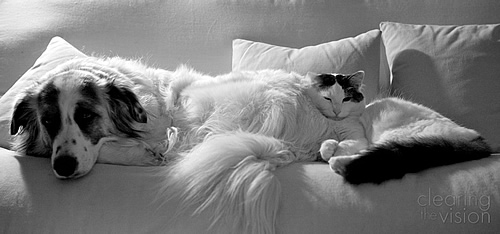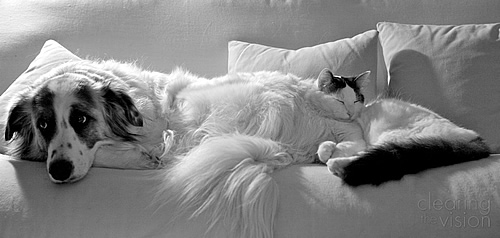
I don’t do pet photography professionally very often, but I find myself taking photographs of our own pets a lot.
Our big sweet Aussie shepherd/Great Pyrenees dog Corrie presents some particular problems when I have a camera in my hand. She’s mainly white with some black on her face, and has deep brown soft eyes.
The dynamic range (from the darkest part of the image to the lightest) is so broad from her white back to her black head that it’s very hard to get a good exposure of her. Unless the lighting is just right, either I expose for the face and her back is blown out, or I expose for her back and her face and eyes are too dark.
The other night when she and the cat (named Colin Feral) were curled up together, I grabbed the camera and tried to get some shots. The pets were lit predominantly from a light behind and above them, with only a little fill coming from a more distant light in front.
There wasn’t enough illumination from the front to light the dog’s face properly. Her eyes were black pits with no detail in them, even though the exposure on her back was borderline too hot. What I needed was some way to even out the lighting while not making it too harsh.

Fortunately we’re in the middle of putting up a new picture rail so there were some framed images to hand which had white foam core on the back of them – a pretty good reflector.
I propped one picture up up below the dog to bounce some of the light from behind her up into her face, giving more even light and a much more attractive photograph.

While I was watching Tamara Lackey’s great Creative Live workshop of children’s portrait photography, I was struck when she said that she uses a reflector (probably not the back of a framed picture) on pretty much all her shoots.
I’ve used my real one a bit, mainly for more considered portraits of older kids, but her technique of shooting round it one-handed while chasing smaller beings around was pretty impressive. This sort of flexibility means you can use it in a lot more situations, but you have to get good at balancing camera and reflector.
Waving it around loosely won’t help you unless it really is bouncing the light the way you want it to. So I’ll be getting in more practice with the dog.